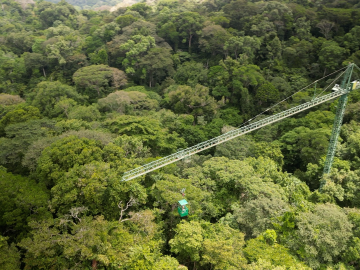
Filter News
Area of Research
- Advanced Manufacturing (12)
- Biology and Environment (54)
- Building Technologies (2)
- Computational Biology (1)
- Computational Engineering (3)
- Computer Science (11)
- Electricity and Smart Grid (1)
- Energy Science (117)
- Energy Sciences (1)
- Fuel Cycle Science and Technology (1)
- Fusion and Fission (13)
- Fusion Energy (7)
- Isotope Development and Production (1)
- Isotopes (5)
- Materials (81)
- Materials Characterization (1)
- Materials for Computing (13)
- Materials Under Extremes (1)
- Mathematics (1)
- National Security (13)
- Neutron Science (31)
- Nuclear Science and Technology (20)
- Nuclear Systems Modeling, Simulation and Validation (1)
- Quantum information Science (4)
- Sensors and Controls (1)
- Supercomputing (46)
- Transportation Systems (1)
News Type
News Topics
- (-) Biomedical (28)
- (-) Clean Water (16)
- (-) Composites (23)
- (-) Environment (86)
- (-) Grid (38)
- (-) Machine Learning (27)
- (-) Materials Science (90)
- (-) Nuclear Energy (47)
- (-) Quantum Science (42)
- 3-D Printing/Advanced Manufacturing (82)
- Advanced Reactors (25)
- Artificial Intelligence (51)
- Big Data (25)
- Bioenergy (42)
- Biology (47)
- Biotechnology (14)
- Buildings (36)
- Chemical Sciences (48)
- Computer Science (105)
- Coronavirus (28)
- Critical Materials (23)
- Cybersecurity (20)
- Education (3)
- Element Discovery (1)
- Emergency (1)
- Energy Storage (75)
- Exascale Computing (14)
- Fossil Energy (2)
- Frontier (17)
- Fusion (26)
- High-Performance Computing (44)
- Hydropower (6)
- Irradiation (2)
- Isotopes (25)
- ITER (5)
- Materials (96)
- Mathematics (3)
- Mercury (5)
- Microelectronics (1)
- Microscopy (28)
- Molten Salt (8)
- Nanotechnology (41)
- National Security (21)
- Neutron Science (81)
- Partnerships (33)
- Physics (30)
- Polymers (23)
- Quantum Computing (18)
- Security (13)
- Simulation (19)
- Space Exploration (13)
- Statistics (2)
- Summit (30)
- Transportation (62)
Media Contacts

Researchers at Stanford University, the European Center for Medium-Range Weather Forecasts, or ECMWF, and ORNL used the lab’s Summit supercomputer to better understand atmospheric gravity waves, which influence significant weather patterns that are difficult to forecast.

The ForWarn visualization tool was co-developed by ORNL with the U.S. Forest Service. The tool captures and analyzes satellite imagery to track impacts such as storms, wildfire and pests on forests across the nation.

Researchers have identified a molecule essential for the microbial conversion of inorganic mercury into the neurotoxin methylmercury, moving closer to blocking the dangerous pollutant before it forms.

Oak Ridge National Laboratory researchers are using a new bioderived material to 3D print custom roosting structures for endangered bats.

Plants the world over are absorbing about 31% more carbon dioxide than previously thought. The research, detailed in the journal Nature, is expected to improve Earth system simulations that scientists use to predict the future climate, and spotlights the importance of natural carbon sequestration for greenhouse gas mitigation.

A new technology to continuously place individual atoms exactly where they are needed could lead to new materials for devices that address critical needs for the field of quantum computing and communication that cannot be produced by conventional means.

A study led by the Department of Energy’s Oak Ridge National Laboratory details how artificial intelligence researchers created an AI model to help identify new alloys used as shielding for housing fusion applications components in a nuclear reactor. The findings mark a major step towards improving nuclear fusion facilities.

A new technical collaboration program at the Department of Energy’s Oak Ridge National Laboratory will help businesses develop and launch electric grid innovations. Sponsored by the Transformer Resilience and Advanced Components program in DOE’s Office of Electricity, the initiative will provide companies with access to national laboratory resources, enabling them to capture market opportunities.

Scientists using high-resolution aerial scans and computational modeling concluded that wildfires, storms and selective logging have become key drivers behind rainforest carbon emissions, outpacing clear-cutting practices.

A team led by scientists at ORNL identified and demonstrated a method to process a plant-based material called nanocellulose that reduced energy needs by a whopping 21%, using simulations on the lab’s supercomputers and follow-on analysis.


